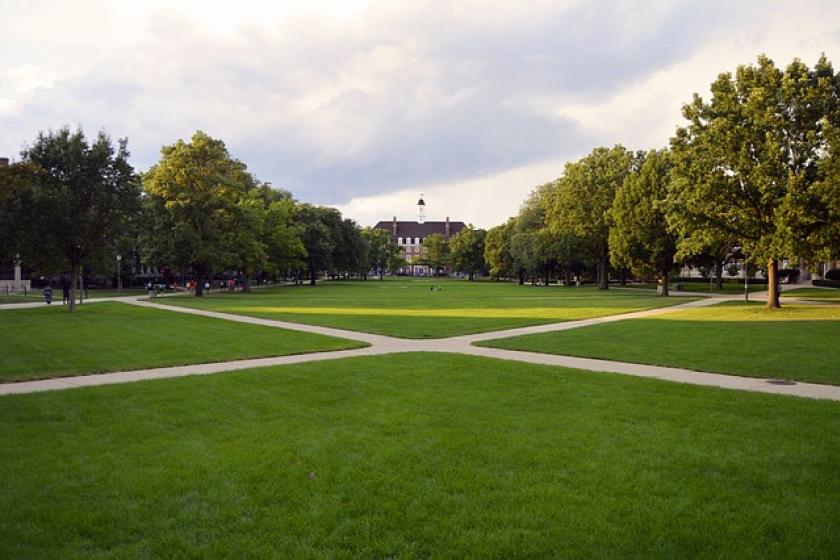The Role of Wi-Fi 6 in the Post-COVID College Campus
By ensuring the right infrastructure is in place to support Wi-Fi 6, colleges (and businesses) can adapt the latest technologies and lead in innovation.
November 6, 2020

Since the onset of the pandemic, enterprises have learned to transition from the office to a remote workforce – a process that has emphasized the importance of reliable connectivity. And businesses are not alone. The same issues affecting them have challenged hospitals, schools, and governments.
College campuses are determining ways to safely stay open this fall and spring semester. Though no one is sure exactly what a post-COVID school season may look like, there are ways in which connectivity – particularly Wi-Fi 6 – will play a key role in powering today’s connected college campuses and dorms by increasing capacity for connected devices, adapting to new technologies and reducing risk by leveraging Bluetooth LE for contact tracing.
More Devices, More Network Capacity
College students are more tech-savvy than ever before. Laptops and smartphones are essential for learning and collaborating with professors and fellow students on campus. However, many students own several additional devices to consume content and stay entertained, including tablets, e-book readers, gaming devices, smartwatches, and more. COVID has also forced colleges to make difficult decisions around eliminating fall break to reduce student risk from travels, making it even more important for students to have immediate access to their loved ones back home via fast, reliable technology. With incoming students owning an increasing number of devices, there is a growing strain on college campus networks and infrastructure.
To adjust for the need of more network capacity, colleges are starting to turn to Wi-Fi 6. Whether it’s a full lecture hall or dorm, these common areas can have up to hundreds of students at a time, creating high-density environments for devices. Wi-Fi 6 allows campuses to support wireless connectivity needs in congested locations, ensuring that students are getting the best experience across all of their devices no matter where they are. And although classrooms and dorms may not be as crowded this school year, it’s important for colleges to prepare for a future post-vaccine, where students will be more dependent on technologies than ever before to stay connected.
The College Case for Contact Tracing
Despite the reduced student body on many campuses this year, colleges are still determining the best ways to maximize precautions and create a safe environment for students and staff. One tool that can be leveraged from enterprises is contact tracing, which can notify employees if they have been in close proximity to an individual who has tested positive for COVID and send alerts if a high number of employees are in a specific area. Given the high foot traffic on a college campus, contact tracing can be an important tool to reduce risk.
Contact tracing will be crucial in making sure that students are notified if they may have been exposed to COVID, urging them to get tested and notify roommates. Although colleges have announced strict rules around the number of people allowed at gatherings and parties this year, some student organizations have already begun breaking them. In this situation, contact tracing can proactively reduce risk by alerting college staff about hotspots where many students are in one place in a given time, with the goal of minimizing large gatherings that exceed campus guidelines.
Improving the Educational Experience
In the classroom, there is an increasing demand for the latest and greatest technology. Recent technological advances have enabled the proliferation of smart classrooms, VR/AR for education, and collaboration tools that make learning more immersive – even for students who are taking classes remotely. And I expect that college campuses will embrace some of these technologies even as students return to campus, driving up the requirements on the network, both in the classroom and college dorms. As our quality of education evolves with these new technologies, Wi-Fi 6 provides the connectivity required for these high bandwidth tools, optimizing performance while decreasing latency.
As new educational technologies continue to emerge in the years to come, Wi-Fi 6 will make it easier and more manageable for colleges to adapt. The goal of these new tools is to improve the overall educational experience for both students and professors. Colleges that have the infrastructure in place to support the latest technologies will be best positioned to spearhead innovation, maintain student satisfaction, and remain a competitive choice for prospective students.
The Future of Learning is Powered by Wi-Fi 6
Although many colleges are doing virtual or hybrid programs during COVID, there is no doubt that Wi-Fi 6 will be an important tool for the future of digital learning. For many colleges, the current shift of on-campus students to remote learning this school year is an opportunity for institutions to update their existing networking infrastructure to create the best educational experience as students return to campus in the future.
We already see forward-thinking institutions like Dartmouth College, who has been upgrading its campus and dorm to Wi-Fi 6 recently, and Massachusetts Institute of Technology (wireless upgrade project), taking advantage of this time to upgrade their networks to handle the new digital learning requirements.
By ensuring that the right infrastructure is in place to support Wi-Fi 6, colleges can rest assured that they will be in a good place to create a safe learning environment, adapt to the latest technologies, and continue to lead in innovation across their respective fields.
About the Author
You May Also Like




